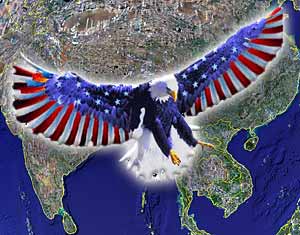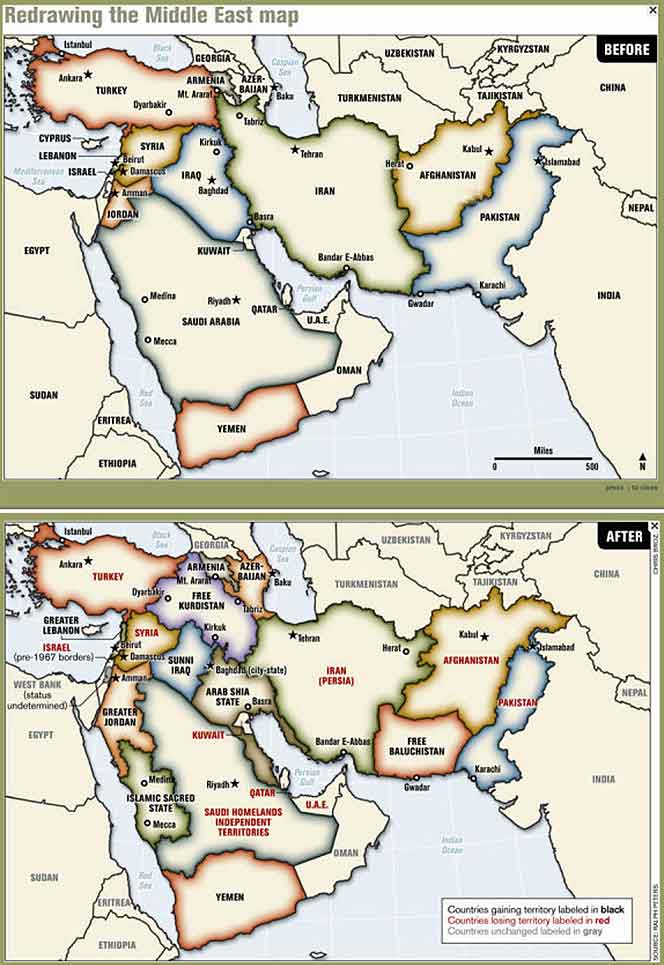26.12.2008
December 24, 2008 (the date of publication in Russian)
Maxim Kalashnikov
EURASIAN SUPER-BALKANS
Destabilization of Pakistan may be a part of a broader US strategy
 The deeper is the recession in the United States, the more unstable is the situation in Central Asia. The latest developments in Pakistan are fraught with a war involving several major powers of the region and revision of their borders, established only half a century ago. The same is true for Iraq, where the "liberation" by the US troops has resulted, in particular, in a dramatic upsurge of the Kurdish national movement, potentially challenging the territorial integrity of Iran and Turkey and echoing with terror in Western Europe. Is all this the result of present weakness of America, or on the contrary, an evidence of transformation of strategy?
The deeper is the recession in the United States, the more unstable is the situation in Central Asia. The latest developments in Pakistan are fraught with a war involving several major powers of the region and revision of their borders, established only half a century ago. The same is true for Iraq, where the "liberation" by the US troops has resulted, in particular, in a dramatic upsurge of the Kurdish national movement, potentially challenging the territorial integrity of Iran and Turkey and echoing with terror in Western Europe. Is all this the result of present weakness of America, or on the contrary, an evidence of transformation of strategy?
For both economic and political reasons, the United States is likely to withdraw its troops from Iraq and Afghanistan. The same is true for the United Kingdom, given its present financial troubles. However, the two retreating empires are not going to leave a battlefield without banging the door. Detailed knowledge of the scene enables the Anglo-American establishment to ignite a huge area of Central Asia before the withdrawal, thus preventing economic progress and geopolitical ascent of Asian states regarded as its major rivals.
In case of a new Indo-Pakistani military conflict with a predictable outcome of Pakistan's disintegration, all kinds of plans of Eurasian infrastructure, involving India, Iran, China, and Russia, will turn a failure, while the existing economic and trade relationship will be disrupted.
In case the inter-ethnic and inter-religious conflict in Iraq spreads outside, igniting neighbor states of the Persian Gulf and the Black Sea coastline, the implications will be sufficient for a long-term instability in Southern Europe. Ten years ago, the "punishment" of Belgrade by Bill Clinton's Administration coincided with the introduction of the single European currency. A strategy, affecting all the potential poles of new global architecture, requires a super-Balkan strategy. It is most attainable to start the game in the part of Eurasia where the borders (like in the Balkans) are relatively new, while a number of peoples had not been granted statehood after the XX-century division of the Middle East and Central Asia.
Plans of carving out Xinjiang from China, Baluchistan from Pakistan, and South Azerbaijan from Iran were vividly discussed already in early 1990s. In 2001, plans of division of Saudi Arabia were made public as well. However, these inventions of strategists were not so highly required at that time, while the Gulf States remained important as a source of hydrocarboms.
The new US leadership preaches transition to alternative energy resources. At the same time, present US military activities at the coastline of the African Horn take place on the background of rumors about huge amounts of oil of the Red Sea shelf that could be used as an alternative to the Gulf's resources.
Fears that a new Asian war would boost oil prices don't work at present. The global financial crisis revises the rules of the game, providing new options for manipulation. In fact, the recent incident in Bombay and the related events demonstrate that in some weak points of Asia, manipulation of states against one another is far less costly than implementation of Paulson's plan.
In 1930s, the Anglo-American manipulation of Germany and Russia against one another eventually made the whole continental Europe a huge battlefield. Regardless from the shape of wartime coalitions, it should be admitted that the net result of World War II was most favorable for the United States.
This time, Asia is a more attractive battleground not only due to abovementioned fragility of borders and young age of nations, but also due to the geography of US rivals. In 1930s, the major rival and target was the Soviet Union. At present, the rival No.1 is the ascending China.
Thus, the choice of Pakistan is considered the best, with a possibility to simultaneously apply scenarios of inter-state, civil, and ethnic conflicts. The new increase of Islamic radicalism is supposed to ignite Xinjiang, with related destabilization of borders of both China and Kazakhstan. The current signs of social destabilization in a number of Chinese cities indicate that the effects of crisis can be instrumental for a double manipulation from outside and inside – for which the Falungong sect, as a cheap and active tool, is perfect.
The effects of economic crisis create additional preconditions for social and ethnic instability also in Russia's Caucasus and the relatively poor states of Southern Europe. Thus, the big fire, initiated simultaneously in Central Asia and the Gulf, is likely to be followed with smaller blasts along from the western and eastern sides, keeping the whole continent in economic and social instability. Potentially, the whole Eurasia may become a "burning island".
In his recent study, Andrew G. Marshall associates the Mumbai attacks with the scheme of "rethinking of the Middle East", developed by British intelligence veteran Bernard Lewis. In Lewis's book, republished in 1992, the territory of Iran was supposed to be split by ethnic insurgencies. These ideas were developed in 2006 by Col. Ralph Peters (see map), supposing division of Iraq into an independent Kurdistan (including oil-rich lands of Northern Iraq along with a portion of Eastern Turkey with the transit pipeline), an Iraqi Sunni state, and a hypothetic Shi'i "Arabistan" with the capital in Basra and borders including parts of the present Iran and Saudi Arabia. At the same time, the supposed fall of the Saudi monarchy would separate Riyadh, now as a center of "independent territories", from Mecca and Jidda, this scenario also suggesting a "Greater Jordan", "Greater Yemen", and "Greater Kuwait".
On the same map, we see Pakistan divided, with a newly-emerged Baluchistan (encompassing also some regions of Iran) and Pashtunistan (Western Pakistan, integrated into an expanded Afghanistan). The most obvious purpose of these two artificial states is to create obstacles for transport of energy resources from Iran to China and India.
The latest events in Pakistan and India, simultaneous destabilization in Turkey and new tensions between Russia and Ukraine over Crimea indicate that such kinds of projects are not just a mere fantasy. The commitment to impede progress of Eurasia and mutually favorable cooperation of its major powers (in a framework designed, particularly, in Yury Krupnov's plan of New Middle East), is likely to be expressed in a number of new dangerous games suggesting an immense self-sustaining destructive potential. Peoples have to keep vigilant.

Number of shows: 1431
 ENG
ENG 

 ENG
ENG 
